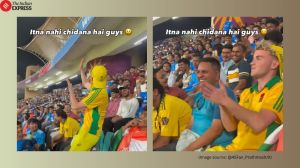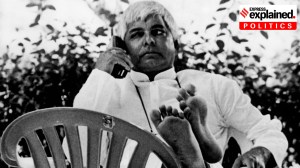GG Raj, Raj 22, and the Rhino Report
Life in the cleaner, greener future is a breeze but for one loss
 GG Raj, Raj 22 and the Rhino Report.
(Credit: Getty Images)
GG Raj, Raj 22 and the Rhino Report.
(Credit: Getty Images)“Back in 2022, we had to change our clothes every day…” began Great Grandpa Raj.
We sat down for another story about the ‘good old days.’ It was a family tradition to allow elders to speak at length about their lives on their birthdays, and to force the impatient young to listen to them. Some of the stories were interesting, but many were repetitive. The seniors could speak for 30 minutes, which was the longest any kid would stay in one place. And GG Raj had just turned 150, so this was an ultra-special occasion.
Modern medical science had progressed so much in superhero leaps and kangaroo bounds that people lived to be 150 easily, and, if they chose, for another 100. Death was a planned event. So, most children had four sets of living great-grandparents and two of grandparents, all fit and fine.
Medical progress also ensured that no living species went extinct after 2050. Which was great for animal lovers like me.
“And we had to go to school every day, by bus,” ended the old timer, “unlike now.” Was he complaining of having to go daily or having to travel? Or the bus? It was obvious that GG Raj had hated school, since he said ‘had to go’ instead of ‘went.’
“Now school comes to you,” said his daughter, G-Ma Pari, formally ending the session. “Come, Papa, it’s time for your walk. Family disperse!”
We dispersed. We switched off our TV walls and went back to what we were doing, in our respective homes, in our respective planets or moons. I returned to my school work; my report on the Great Indian Rhino. There was no hurry; I had enough time. But would I postpone this labour of love?
My name is Raj too, short for Raj-22. And this is 2162. I am 13, and I stay with my parents in the greenest part of Planet Gr33n. My parents had been one of the first to migrate from good old Earth to Gr33n 20 years ago.
“We were responsible migrants,” my father said. “We knew what damage humans had done to Earth. So we kept Gr33n almost as green it was since we came here. Building material used was biodegradable, and thanks to engineers like your mom, all damage was responsibly compensated. Trees, water bodies, animal habitats …”
If GG Raj’s days were good and old, my days were the best and new. Now, to prepare my report on the Indian rhino, I could be with and study the handsome beast in real time. I put on my Virtual Reality visor, and the gloves, which was what school meant in the 22nd century. Like G-Ma Pari said, we did not have to go to school. The VR system was entertainment and communications too, much like the mobile phone that GG Raj swore by.
In a few minutes, I was in the Kaziranga National Park, caressing the coarse hide of the Rhinoceros unicornis. The VR machine allowed me to feel texture, temperature and even smells, but it was just one way. My presence there only existed digitally. I did not disturb or damage nature in any way.
“How are you, Ranga?”
I had visited this herd before, about nine times, purely out of personal interest, not due to school work. I knew Ranga since she was a newborn calf. She was unaware of my presence, and continued to trample on the long grass, which made the stalks bend down to the level of her mouth. A mynah flew over to peck at Ranga’s hide. After the little bird had disposed off two insects, it swooped down to the rhino’s feet for more.
“Keeps the rhino clean, and the bird fed,” I recorded my observation.
“Symbiotic relationship,” added the voice of my virtual teacher. “Symbiosis is a close relationship between two different kinds of organisms. There are three basic types of symbiotic relationships: mutualism, commensalism, and parasitism. Mutualism is a relationship in which both organisms benefit.”
“Mutualism it is, then,” I said. Ranga Rhino seemed to be a loner, but bobbed her head and nuzzled noses when a friend approached us. This friend, whom I promptly named Minu, for future reference, had brought her calf along.
“And you are Kuttu,” I bent down to scratch the playful little chap.
I stayed there till evening, only breaking off for lunch. I ran after Kuttu and her friends, wallowed with the others in the lakes, and watched two bull rhinos fight. Evening for me was night at the park, so I could observe the herd’s behaviour at night time, too.
“Dinner’s ready, Rajoo!” It was my father’s turn to cook today. We were an old-fashioned family in many ways. We cooked food like in the past, instead of asking a machine like the Kitchikook to do it for us.
“Good night, Ranga.” I patted the gently snoring Ranga’s back.
I finished recording my observations and inferences, and logged off. The report would be automatically submitted to my school. I smiled. GG Raj had to type everything down and mail it to his human teacher. His own father from a rather painful past, had to write with pen on paper, I remember him saying. Good old days? Ha, ha, I live in the best.
Only thing is, most people were illiterate these days. About 10 per cent of the population. Unlike GG Raj’s time, you did not need to be able to read or write to survive. Audio and video files were enough; text was not necessary. You spoke to machines, and machines spoke to you. Languages did not suffer; everybody spoke at least three. Only a few like my parents and I continued to read and write. For pleasure, not for need. We were old-fashioned that way, too.
But best times do not last. Scientists were working on thought transference. Future technology would mean communication by pure thought, they declared. There would be no need for words at all.
The Great Indian Rhino would survive; languages will become extinct.
Chennai-based Ashok Rajagopalan is a writer and artist of children’s books. His latest is the Gulgulseries (Talking Cub)



- 01
- 02
- 03
- 04
- 05



























